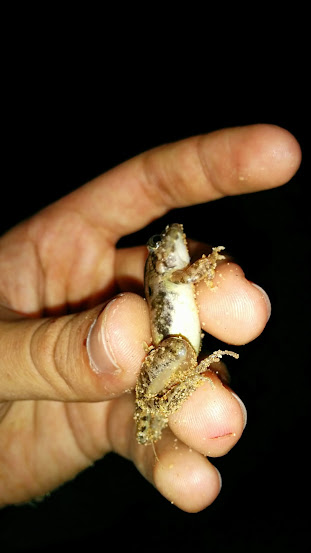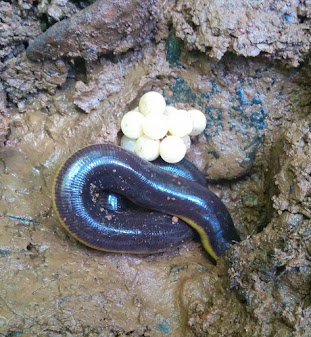 |
| Beddome's Caecilian with eggs |
Date:
January 11th and 12th 2015
Species Found:
- Indian Dwarf Gecko (Cnemaspis heteropholis)
- Yellow Bellied House Gecko (Hemidactylus flaviviridis)
- Southern Flying Lizard (Draco dussumieri)
- Bicolored Frog (Clinotarsus curtipes)
- Common Skittering Frog (Euphlyctis cyanophlyctis)
- Kudremukh Cricket Frog (Zakerana kudremukhensis)
- Yellow Bush Frog (Raorchestes luteolus)
- Roux's Forest Lizard (Calotes rouxii)
- Beddome's Caecilian (Ichthyophis beddomei)
- Bombay Caecilian (Ichthyophis bombayensis)
- Brahminy Skink (Mabuya carinata)
- Malabar Pit Viper (Trimeresurus malabaricus)
Background:
I had heard a lot about Agumbe and always wanted to make a trip there. Over the winter break I managed to make a trip there with my dad, with the purpose of visiting the research stations to enquire about doing a 3 month internship over the summer. While I was there, I was lucky enough to see 12 species that I had never seen before.
The Trip:
We arrived in Agumbe early in the morning on the 11th. By around 9 am we made it to ARRS, the Agumbe Rainforest Research Station. There, we met with a few herpetologists, researchers and volunteers who were conducting various studies in the rainforest. They told me that none of the wildlife was to be handled as many of the studies involved the animals in their natural habitat and catching them would disturb them. This was new to me as I was used to holding animals and photographing them from up close, but I understood their point. As a result, many of the photographs may not be as detailed.
While looking around the campus, I saw a familiar looking gecko on some roof tiles. I identified it as a member of the Cnemaspis genus. One of the researchers there told me that it was Cnemaspis heteropholis, a close relative of the Cnemaspis mysoriensis that I was so used to seeing in Bangalore. C. heteropholis was a lot darker than C. mysoriensis but about the same size and proportions. I have included a photo of C. mysoriensis from Bangalore for comparison.
 |
| Cnemaspis heteropholis |
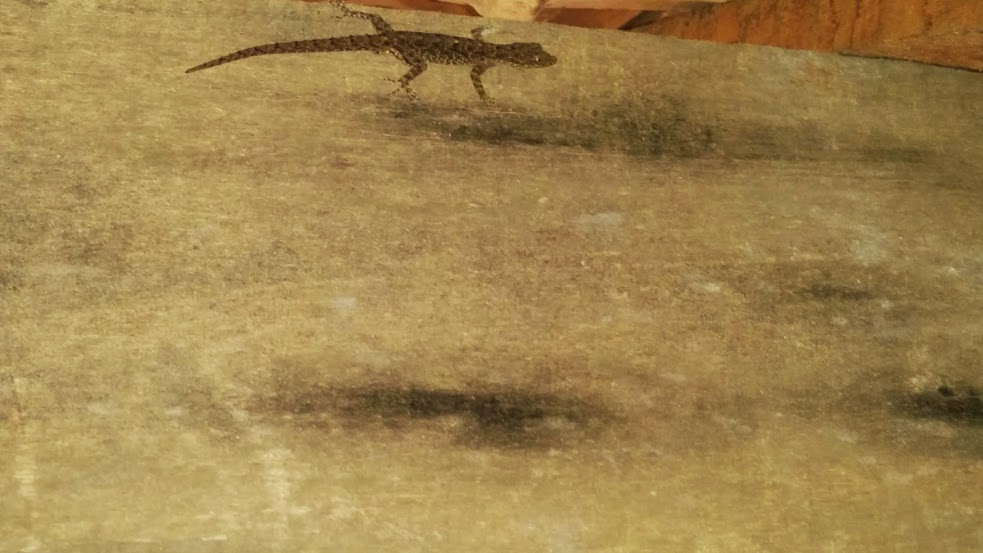 |
| Cnemaspis heteropholis |
 |
| Cnemaspis mysoriensis for comparison |
At ARRS, we didn't see any more herps but we did watch a whole hive of bees get relocated into a hive box for the purpose of Apiculture and honey collection. That whole procedure was quite fascinating as first the honeycombs had to be transferred to the box and then the bees, particularly the queen bee. What made it even more interesting was that the bees had to be transferred by the handful and the person transferring them was using just his bare hands and getting stung in the process. The queen was high up in the corner of the hive, which was in the hollow of a dead tree so it took a good 3 hours to get her out and into the box.
 |
| Honeycomb |
 |
| Removing bees from hive |
 |
| Transferring bees to hive box |
 |
| Hive box with gate |
Later that night, in our hotel room my dad spotted a large wall lizard. It looked a little different from the House Geckos I was used to seeing in Bangalore so I caught it and inspected it further. I found that it was a Yellow Bellied House Gecko, a relative of the regular House Gecko found in Bangalore.
Again, I have included a photo of Hemidactylus frenatus for comparison.
 |
| Yellow Bellied House Gecko |
 |
| Yellow Bellied House Gecko |
 |
| Yellow Bellied House Gecko |
 |
| Regular House Gecko for comparison |
The next day we went to another research base called Kalinga Center for Rainforest Ecology. The base was set up on a Areca Nut plantation with an artificial pond and stream cutting through it. Inside the forest nearby there was a natural stream and dense foliage. The first herp we saw there was a Draco Flying Lizard high up on an Areca tree. It was too far away to get a picture of. In the artificial pond there were many large Bicolored Frog Tadpoles. They were black in color and about 3-4 inches in length.
 |
| Bicolored Frog Tadpoles |
We also saw some Common Skittering Frogs in the artificial pond. I didn't get any close-up pictures of these until we saw more in the natural stream in the forest.
 |
| Skittering Frog in pond |
 |
| Skittering Frog |
Before heading into the forest, the intern, Udit, saw a baby Roux's Forest Lizard in a low bush near the pond. This looked really similar to the Oriental Garden Lizard found in Bangalore but the adult males are easy to tell apart as Forest Lizards have a fully red head. Also, the ranges of both species don't overlap too much.
 |
| Baby Forest Lizard |
 |
| Baby Forest Lizard |
Next, we headed into the forest to look for herps near the stream. I saw a lot of frogs but I could only get pictures of a few. Only the ones that I could photograph are included here. The most abundant frogs there were Skittering Frogs but I also found a Kudremukh Cricket Frog and a Yellow Bush Frog.
 |
| Kudremukh Cricket Frog |
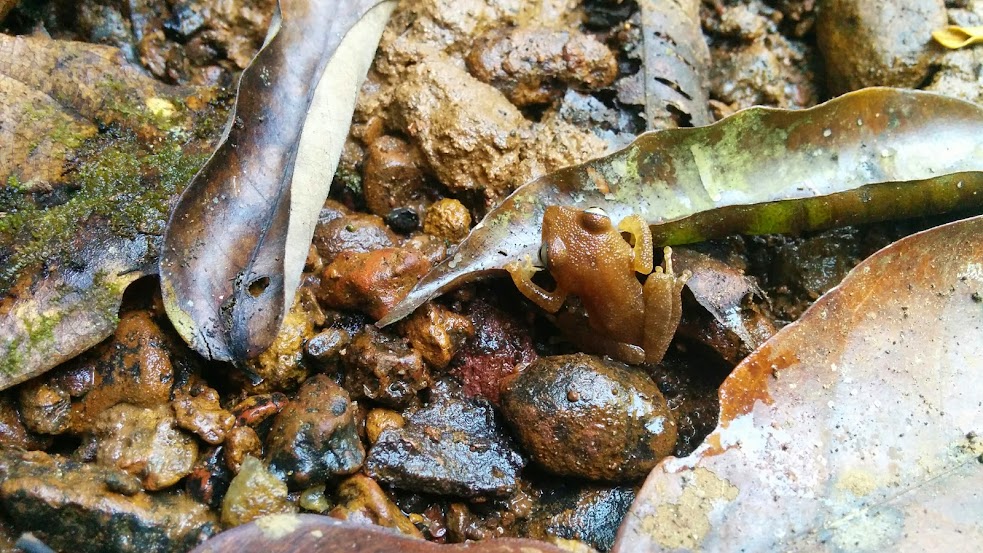 |
| Yellow Bush Frog |
Under rocks near the stream we found crabs, frogs, leeches and a herp I had never seen before: caecilians. Caecilians are legless amphibians and 2 types are found in Agumbe, Beddome's Caecilian and Bombay Caecilian. Fortunately we found both species within 10 minutes of each other, and what's more, the Beddome's Caecilian had eggs!
 |
| Crab |
 |
| Beddome's Caecilian with eggs |
 |
| Bombay Caecilian |
Udit saw a Beddome's Keelback Snake but it escaped into a hole before we could get a look at it. We then headed back to the dining area for lunch. While we were eating, I saw a large Brahminy Skink running on the roof. I also found a baby Brahminy skink as we were heading back from KCRE.
 |
| Brahminy Skink |
 |
| Brahminy Skink |
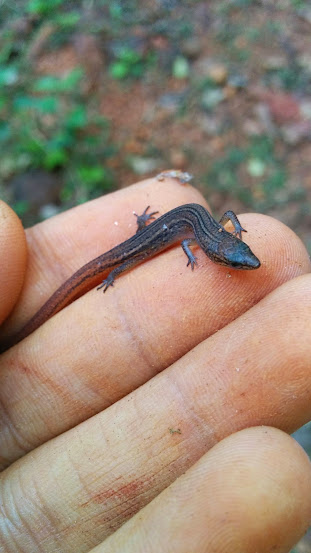 |
| Baby Brahminy Skink |
Before we headed back, Udit showed us a Malabar Pit Viper that he had been observing for a few weeks. He knew where it hid during the day so he found it quite easily. Seeing this tiny venomous snake was a great way to end my winter trip to Agumbe.
 |
| Malabar Pit Viper |
This trip gave me 12 species to add to my Indian Herpedex. Rather, I was able to identify 12 species. In reality we probably saw around 25 species that we couldn't identify or get pictures of. Also, this is the off season, when most of the wildlife is inactive. I hope to go to Agumbe again during the monsoon season when the whole forest is alive. I expect to see at least 4 times the number of species then.


































